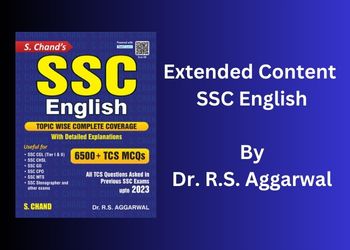About this course
The course ensures that it covers all the necessary topics and question types that have appeared in the SSC Exams like CGL, CPO, CHSL, GD and MTS.
To provide a clear overview, we have divided the the supported book into 13 chapters, each focusing on a different aspect of General English.
To aid your practice and assess your progress, each chapter has strategically crafted exercises. These exercises have been designed into 3 parts: Exercise A for SSC GD and MTS Exams, Exercise B for SSC CHSL Exam and Exercise C for SSC CGL and CPO Exams. The chapters encompass a wide range of topics, including synonyms, antonyms, one-word substitution, comprehension, sentence completion, spotting errors, sentence improvement, rearrangement of sentences, idioms and phrases, and spelling test.
This course encompasses a total of 500 thoughtfully compiled TCS questions. In addition, it provides comprehensive answers to all 500 questions, enabling you to evaluate your performance and enhance your understanding of the subject matter.
FAQ
Comments (0)
The concept of Synonyms has been tested in almost every competitive examination. There are questions on this concept without fail. Synonyms test the candidate’s knowledge of English vocabulary. The words that mean the same or have similar meaning are called synonyms.
Synonyms refer to words that have same or similar meanings. This meaning can be difficult to distinguish, but one can find it easily after thorough practice.
The concept of Antonyms has been tested in every competitive examination. There are questions on this concept without fail. Questions on Antonyms test the candidate’s knowledge of English vocabulary.
Antonyms refer to word pairs that mean the opposite of each other.
One Word Substitution is a crucial vocabulary concept. One word substitution in English improves the clarity, simplicity, and efficiency of communication. One Word Substitution questions are ones in which a phrase or sentence is substituted by a word that fully captures the meaning of the entire phrase. The sentence structure becomes more precise when one word is changed. Many national-level tests, including the SSC CGL, CPO, CHSL, GD and MTS regularly include one-word substitute problems.
To comprehend means ‘to understand and grasp’. A comprehension exercise is, therefore, meant to test a candidate’s ability to understand and retain the contents of a given passage. Trend of Questions: In this type of questions, generally a long passage consisting of certain paragraphs is given, followed by 4—10 questions based on it. The questions may be based on:
(i) Theme of the passage
(ii) Choosing the correct or wrong statement on the basis of the given passage
(iii) View of the author regarding the main points discussed in the passage
(iv) Synonyms or Antonyms of some selected words in the passage
Technique of Solving:
1. Read the passage carefully once and detect its theme.
2. Note what the questions are about.
3. Answer the questions.
In questions on Synonyms & Antonyms, the answer is to be given according to the sense in which the word has been used in the passage, not just on the basis of its literal meaning.
Sentence completion or fill in the blank type questions test the candidates ability to understand the context of the English language.
Spotting errors type questions test the candidate’s knowledge of the concepts of English Grammar. These questions have sentences that are broken into segments, and one has to spot the segment with errors. The error could be in the noun, pronoun, verb, adverb, adjective, tense, gender, singular or plural part of the sentence.
This chapter is analogous to ‘ Spotting Errors’. In this type of questions, a sentence is given with a word or phrase underlined. The candidate is required to examine this underlined part in accordance with the rules of grammar usage and vocabulary and decide upon its correctness.
Some substitutes to the underlined part are given below the sentence. The candidate is required to choose the alternative which when substitutes the underlined part, the sentence becomes grammatically correct. If the underlined part is correct as it is, then the correct option is ‘No improvement’ or ‘No correction required’.
In this type of questions, four sentences are given and labelled A, B, C, D or P, Q, R, S. They are the sentences of a paragraph given in a jumbled order. The candidate is required to arrange these sentences in a meaning full sequence and then choose
the correct order from among the alternatives provided:
In this type of questions, four sentences are given and labelled A, B, C, D or P, Q, R, S. They are the sentences of a paragraph given in a jumbled order. The candidate is required to arrange these sentences in a meaning full sequence and then choose
the correct order from among the alternatives provided:
In this type of questions, an idiom is given followed by four alternatives. The candidate is required to choose that alternative which correctly expresses the meaning of the given idiom.








